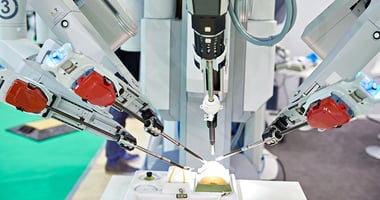From its beginning as a relatively simple machine to help people transport heavy equipment to the...
Collaborative Robots in Industrial Automation
Collaborative robots (“cobots”) is the fastest growing segment in industrial automation. Cobots interact with humans in a shared workspace, whereas traditional robots function in relative isolation from human contact. Cobot operation generally incorporates various safety features like lightweight construction materials, rounded edges, limited speed and force, and sensors and software to ensure safe operation. A variety of cobot applications have emerged to improve operational efficiency, reduce on-the-job accidents and injuries, and lower operating costs. These include applications in home healthcare, warehouse maintenance, space exploration, pick and place (including material handling, packaging, and palletizing), bomb disposal, and even food preparation. Additional factors driving growth has been steadily decreasing prices and ease of implementation. Many cobots cost less than $45, 000 and, with advances in edge computing, integration costs are minimal because little or no programming may be required. In this article, we take a closer look at some of these amazing cobot applications.
Home Healthcare
The U.S. population is aging, and the availability and affordability of home healthcare is a national issue. As the Boomer generation ages, the U.S. finds itself on the cusp of dealing with an unprecedented number of people requiring home elder care. In fact, the home elder care market, which was $100 billion in 2016, will be $225 billion by 2024. The increase is being driven by the expanding elderly population that is projected to increase 147% during the period 2000 to 2050 and from an overwhelming preference of older people to age in place. With this aging come concerns about the availability and affordability of healthcare.
One company offering a cobot solution is Comfort Keepers. Its multi-functioning robot companion known as “Rudy” can perform injections, wound care, ostomy care and more. Rudy can help seniors in several other ways through simple voice commands. Rudy can illuminate dark areas, call for help, carry things, set reminders, assist patients who need to use the restroom, and call family members or loved ones. Nurses or family members can even take control of Rudy and drive it around a senior’s home using an app. At a cost of around $5,000.00, it is comparable to the cost of a human home health worker.
Warehouse Maintenance
Robotics applications have begun to address warehouse maintenance. Cobot janitors, are more consistent, less expensive, faster, and safer than human labor for the dirty, and often dangerous work, of industrial facility cleaning. One application, the Minuteman Max Ride 20 RoboScrubber, has a vision-based artificial intelligence system that enables the robot to navigate complex, real-world warehouse environments to clean the floors. The machine works safely and efficiently alongside employees, and employees have the option to using it in manual mode. Advancements in big data analytics and the Internet of Things offer warehouse operations staff more diverse robotics solutions such as engaging sensor robots for fleet management/tracking in real time, and the ability to make data-driven decisions that improve overall performance from understanding where the bottlenecks are.
Space Exploration
One of the most interesting cobot initiatives relates to NASA’s future mission to explore one of Saturn’s moons that scientists have speculated is similar to Earth. The mission includes plans to deploy 12 miniature shape-shifting cobots that can withstand Titan’s environment that includes freezing temperatures as well as lakes, caves, seas, and liquid hydrocarbon rain. Propellers on the cobots will enable them to swim or fly to reach places humans could not explore on their own. Currently, NASA is testing a prototype.
If the exciting prospect of space exploration is to continue, we will need to address the problem of “space junk.” Our atmosphere is becoming cluttered with space debris at an alarming rate. Decades of astronauts dumping garbage into the atmosphere in orbit, as well as defunct satellites from many countries and, now, private companies, threaten future development and space exploration itself. Currently, there are 6,000 satellites circling Earth. 60% of those are defunct. Cobot technology could help solve this problem. One company proposes the use of self-destructing “janitor satellites” that could seek out and attach to the debris. The explosion the debris into smaller pieces and forces reentry to the atmosphere where the pieces would incinerate completely before hitting the ground.
Pick and Place Many industries use pick and place cobots for their ability to perform highly repetitive and precision tasks. Some of these applications function alongside humans, while others operate autonomously. In the latter case, autonomous cobots allow for even greater productivity and workforce flexibility. Pick and place cobots are easy to program. Operators can deploy small cobots to tighter spaces and other production lines easily. The most common uses are for assembly, bin picking, finishing tasks like polishing and grinding, material handling, packaging palletizing, depalletizing, and inspection.
Bomb Disposal Robots have been in use to diffuse bombs for almost 50 years. Although the early predecessors to today’s bomb disposal applications were crude, they were moderately successful in rendering an explosive device inert by spraying a high pressure jet spray of water to disconnect wires. In many cases, though, the strategy was to move the bomb to a safe place to be detonated. Operators of the early versions maneuvered the robot in place with a ropes.
The purpose of modern bomb disposal cobots focuses on rendering an explosive device inert without an explosion. They can be used for landmines and unexploded munitions, too. Positioning and control of the cobot is by wireless communication. Cameras and sensors enable bomb detection capabilities, which the early versions did not have. A prototype in the testing phase presently, can jump walls and fences.
Food Preparation At least one technology company has come up with a robot that can prepare food with zero human contact. Waveland Labs has devised a fully automated pizza kiosk. It can create and cook a made-to-order artisan pizza in 3 minutes using high-quality ingredients with no human assistance in the process. The kiosk, aptly named “Piestro,” has proven to reduce waste, produce consistent high-quality pizzas at a much lower cost of operation. Customers can watch their pizza being made through a large window in the cobot, making the experience an interactive one.
From a financial perspective, the news is even better. Traditional profit margins for pizzerias have averaged 22% because pizza-making is labor intensive. Piestro’s automated process boasts a 48% profit margin. The inventor of Piestro, Massimo Noja De Marco, plans to allow existing brick and mortar chains to white label the kiosks, allowing expansion to a larger geographic and demographic reach, including regional and nationwide chains.
As cobots continue to evolve, we can expect scientists and engineers to devise more uses for the technology. Cobots may hold the key to safer work environments, better products and services at lower costs, and a cleaner environment.



